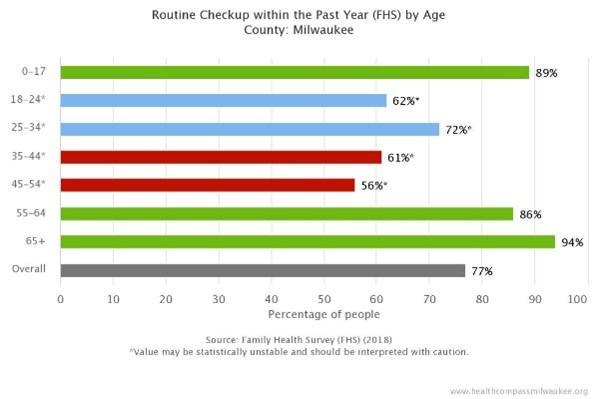Access: Primary Care
Primary Care
Within the access strategy of expanding primary care capacity for low-income and uninsured individuals, Milwaukee Health Care Partnership (MHCP) members have engaged in a number of strategies — collectively and independently — to help close the gap in access to primary care medical services:
- Increasing the capacity and capabilities of Milwaukee’s five Federally Qualified Health Centers (FQHC)
- Enhancing capabilities of select, full-service free and charitable clinics
- Supporting health systems’ primary care access strategies
Offering a usual source of care, early detection and treatment, chronic disease management, and preventative care, access to primary care has a profound effect on a person’s health. Increasing the availability, accessibility, and acceptability of primary care is a vital step in improving the health of our residents.


Milwaukee’s health systems have directed more than $25 million in support to community clinics to expand programs and services, improve clinical capabilities, enhance health information technology, and establish care coordination and social work services.
Primary Care Access Studies
MHCP’s 2008 Primary Care Access Study has served as the foundation for a long-range plan to address the need for access to primary health care services. The study found that while the county had an adequate supply of primary care providers based on physician-to-population ratios, profound shortages existed in the neighborhoods with the greatest medical need.
The MHCP’s 2019 Milwaukee FQHC Capacity Building Plan provided an updated analysis of gaps in access in primary care access in Milwaukee County to supplement the 2008 study and inform a primary care capacity building plan for Milwaukee’s FQHCs to expand access for low-income populations. The analysis mirrored the 2008 study in finding an oversupply of primary care providers in Milwaukee County with significant gaps in primary care clinic locations persisting in key zip codes, particularly for Medicaid beneficiaries and the uninsured.
- In Milwaukee County, 40.2% of the population is low-income and most heavily concentrated in four zip codes.
- There continues to be high rates of avoidable ED utilization, especially among Medicaid beneficiaries.
Nationally, the gap in primary care access is approximately 20% for all populations and 30% for vulnerable populations. In Milwaukee County, the gap was significantly greater — 54% for vulnerable populations — underscoring the need for strategies to address unmet healthcare needs.
Free and Charitable Clinic Capability
The Free and Community Clinic Collaborative (FC3) of Southeastern Wisconsin is a coalition of over 20 safety-net clinics that provide free and low-cost medical services to uninsured and underinsured individuals in our communities. The MHCP helps sponsor FC3’s collaboration and resource sharing and has also secured funding for individual FC3 clinics’ social navigation services and access to health information exchange technologies like WISHIN and PatientPing.